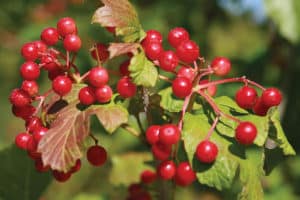By Bonnie Kirn Donahue
Berry season in Vermont can feel like a beautiful, fleeting moment in time. How can we make it last longer?
You may be familiar with common types of berries that can be grown here, such as raspberries, blackberries, blueberries, grapes and strawberries. Growing different varieties of these species is one way to make the season longer.
However, there are far more berry species that can be grown in Vermont than you might expect. Trying out new varieties of berries is a great way to extend berry season.
Berries in the Ribes species, including currants and gooseberries, are both tart and sweet and can be eaten fresh or used in jams, jellies, baked goods and sauces. In addition to sweet dishes, currants can be paired nicely with savory dishes such as soft cheeses, made into spiced chutneys or used to glaze meats like pork, lamb and game.
Available in many varieties and colors, currants and gooseberries can range in color from yellow to green, pink to white and red to black. Varieties like “Pink Champagne Currant” grow 3-5 feet tall and wide, and “Hinnomaki Red Gooseberry” will grow 2-5 feet tall and 3-6 feet wide.
Currants and gooseberries are self-fruitful or self-pollinating, so you can experiment with just one shrub to start if you wish. They can grow in part-shade as long as there is good air circulation and nitrogen-rich, well-drained soil.
Gooseberries are about the size of grapes, growing individually along a stem. Currants are pea-sized fruits that grow in clusters like grapes. Both are ready to harvest in July.
The American highbush cranberry (Viburnum opulus var. americanum) is a great ornamental shrub with edible fruit. Growing 8-12 feet tall and wide, this shrub has showy white flowers in the spring and purple-red foliage in the fall.

The American highbush cranberry grows 8-12 feet tall and wide and has edible red berries that can be eaten fresh, added to baked goods or preserved as jam.
This versatile shrub likes full to part sun and average soils that are well-drained. The bright red, tart berries can be eaten fresh or cooked into jams and baked goods.
Hardy kiwi (Actinidia spp.) is another incredible berry-like fruit that can be grown in Vermont. Miniature kiwi fruits (that taste like kiwi!) grow on large, twining vines. The vines are thick and woody, so you will need a strong support system like a pavilion or other solid frame.
To produce fruit, the hardy kiwi requires both a male and female variety, so plan accordingly.
Honeyberry or haskap fruits (Lonicera caerulea) look like elongated blueberries and can be eaten fresh or canned. The shrubs grow 4-6 feet tall and wide and appreciates full to part-sun and moist, yet well-drained, soil. Two varieties are needed for cross-pollination.
Seaberry or sea buckthorn (Hippophae rhamnoides) has lovely orange berries that can be used to make flavorful juices and jams. These shrubs grow 8-12 feet tall and wide, prefer full sun and tolerate poor, sandy soil and wind. They have attractive silvery foliage, which makes them a nice shrub for the garden or berry patch.
Like the hardy kiwi, the seaberry requires planting both male and female varieties to produce fruit.
Vermont has exceptional local experts on these unique berries. Ask your local greenhouse and nursery staff and farmers about their experience growing berries in your area. In the meantime, the “Cornell Guide to Growing Fruit at Home” is a helpful resource to get started. It can be found at go.uvm.edu/growingfruit.
Here’s to getting the most out of our short summer season by growing more berries!
Bonnie Kirn Donahue is a UVM Extension master gardener and landscape designer from central Vermont.




